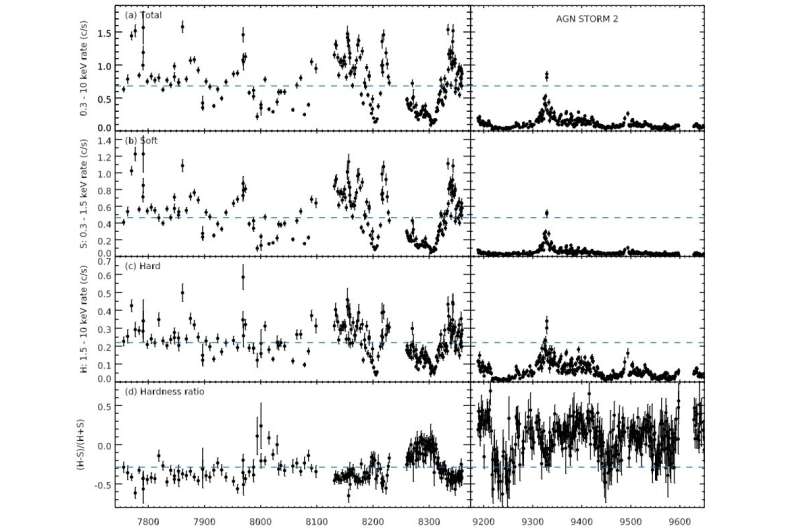July 10, 2023 report
This article has been reviewed according to Science X's editorial process and policies. Editors have highlighted the following attributes while ensuring the content's credibility:
fact-checked
preprint
trusted source
proofread
Observations shed more light on the properties of the galaxy Markarian 817

Using NASA's Swift spacecraft, an international team of astronomers has carried out a long-term multiwavelength monitoring of a nearby active galaxy known as Markarian 817. Results of the observational campaign, published June 30 on the preprint server arXiv, yield important insights into the properties of this galaxy.
An active galactic nucleus (AGN) is a compact region at the center of a galaxy, more luminous than the surrounding galaxy light. AGNs are very energetic due either to the presence of a black hole or star formation activity at the core of the galaxy.
Seyfert galaxies are a subclass of active galaxies and are categorized as nearby, low luminosity, radio-quiet AGNs hosted in spiral or lenticular galaxies. They are further classified as Type 1 or 2, depending on the emission lines shown by their spectra.
Located some 430 million light years away in the northern constellation of Draco, Markarian 817 (or Mrk 817 for short) is a nearby Seyfert 1 galaxy. The galaxy has an angular size of about 0.513 arcminutes and radial velocity at a level of 43,761 km/s.
Recently, Markarian 817 has been the target of the AGN STORM 2 project—a large, coordinated, multiwavelength reverberation mapping campaign. A group of astronomers led by Edward M. Cackett of the Wayne State University in Detroit, Michigan, has monitored Markarian 817 with Swift for 15 months, obtaining observations in X-rays and six ultraviolet/optical filters, in order to shed more light on the structure and properties of this galaxy.
"The Neil Gehrels Swift Observatory (hereafter Swift) monitored Mrk 817 daily, concurrently with HST [Hubble Space Telescope], with 1 ksec observations for ∼15 months from November 22, 2020 to February 24, 2022," the researchers explained.
The observations found that the 0.3–10 keV X-ray count rates are on average a factor of 6 fainter than archival observations. Moreover, the X-ray count rates show suppressed variability aside from a large flare, which peaks close to the historical mean flux. The X-ray spectrum of Markarian 817 turned out to be heavily obscured.
The Swift ultraviolet/optical light curves are highly variable throughout the whole observational campaign. The astronomers noted that despite the X-ray count rate being significantly fainter, the ultraviolet flux remains almost unchanged when compared to archival data. They added that the X-ray band appears to be poorly correlated with the ultraviolet/optical light curves throughout the observing period.
Furthermore, Swift ultraviolet/optical light curves showcase interband continuum lags that increase with increasing wavelength. These light curves show a period at the beginning where the strength of the variations in the continuum is suppressed compared to later periods. The authors of the paper ponder different scenarios that could explain such behavior.
"We suggest that this indicates a significant contribution to the continuum from the broad line region gas that sees an absorbed ionizing continuum," the researchers noted.
Therefore, Cackett's team proposes further extended monitoring of Markarian 817 with Swift and ground-based facilities in order to explain the observed light curve properties of this galaxy.
More information: Edward M. Cackett et al, AGN STORM 2. IV. Swift X-ray and ultraviolet/optical monitoring of Mrk 817, arXiv (2023). DOI: 10.48550/arxiv.2306.17663
Journal information: arXiv
© 2023 Science X Network





















